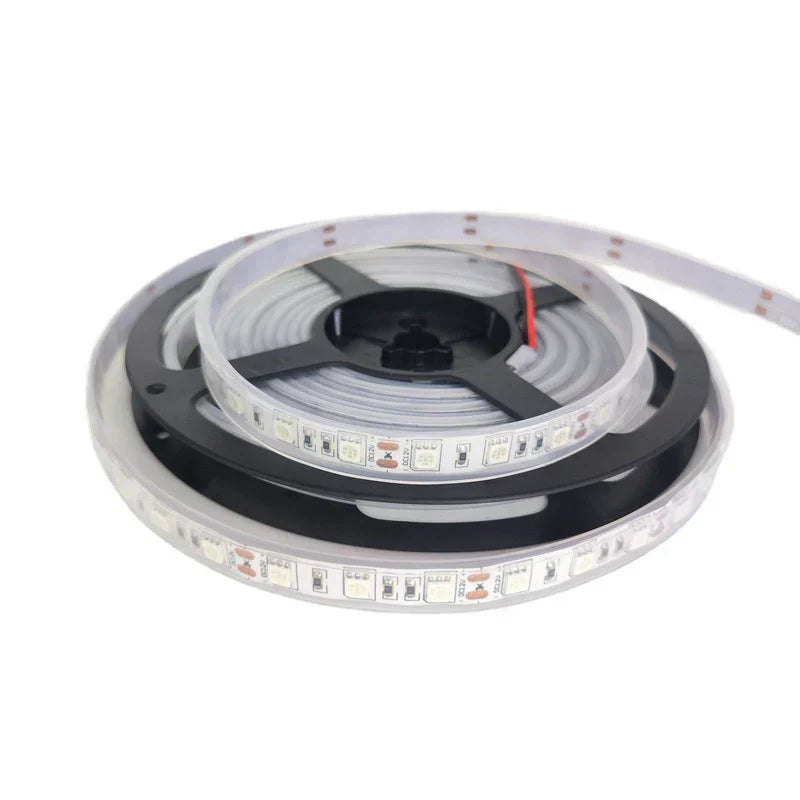In modern lighting design, Flexible LED Strips have become a cornerstone of architectural, commercial, and residential illumination. Compared with traditional rigid lighting, flexible strips offer not only superior brightness and efficiency but also remarkable structural flexibility and control adaptability.
This article explores the key technical advantages of flexible LED strips — Durability, Efficiency, and Versatility — and explains why they have become the preferred solution for professionals and lighting enthusiasts alike.
1. Durability: Optimized from Structure to Materials
One of the most impressive characteristics of flexible LED strips is their mechanical robustness and environmental adaptability.
Instead of using rigid aluminum or glass substrates, flexible LED strips are built on FPC (Flexible Printed Circuit) materials, which feature excellent bendability and vibration resistance — ideal for curved surfaces, corners, or complex architectural layouts.
In terms of protection, flexible strips come in various IP ratings (IP00–IP67) to suit different environments. For instance, IP67-rated models are completely dustproof and water-resistant, suitable for outdoor or humid conditions.
Meanwhile, advancements in LED packaging technology — such as the SMD2835, SMD5050, and SMD5630 series — have significantly improved thermal management and aging resistance, ensuring stable light output even after thousands of hours of continuous use.
2. Efficiency: Perfect Balance of Brightness and Power Consumption
Energy efficiency is one of the primary reasons flexible LED strips are so widely adopted.
Compared with traditional fluorescent or incandescent lights, LED strips can reduce energy consumption by up to 80% while delivering comparable brightness.
High-Efficiency LED Chips
Premium LEDs, such as Samsung and LG SMD5630 chips, can deliver over 1000 lumens per meter with excellent color uniformity, minimizing visual inconsistencies.
Precision Circuit Design
Optimized copper thickness (typically 2oz) and circuit layout ensure low voltage drop and minimal power loss, maintaining consistent brightness even in long runs of 5–10 meters.
High CRI with Low Power Usage
Many advanced LED strips offer CRI > 90 while consuming only 10–12W per meter, providing natural and comfortable illumination ideal for both workspaces and living environments.
3. Versatility: Endless Possibilities for Creative and Intelligent Lighting
Flexible LED strips are often called the “light brush for designers” — thanks to their adaptability in both installation and control.
Flexible Installation Options
With adhesive backing, mounting clips, or aluminum channels, these strips can be easily installed in various settings such as cove lighting, cabinet lighting, signage, showcases, and automotive interiors.
Wide Range of Colors and Brightness
Available in single-color white (3000K–6000K) or multicolor RGB configurations, they allow users to fine-tune both tone and intensity to create customized lighting atmospheres.
Smart Control Compatibility
Many models support Bluetooth, Wi-Fi, or Zigbee protocols, making them compatible with smart home systems like Alexa and Google Home, enabling remote control of brightness, color, and dynamic effects.
4. Featured Products: Reliable and High-Performance Flexible LED Strips
Below is a selection of LEDLightsWorld’s top-quality flexible LED strip products. Each model offers distinct advantages in chip type, brightness, and waterproof rating — perfect for different applications:
|
Product Name |
Key Features |
IP Rating |
Link |
|
Samsung & LG SMD5630 LED Strip Light |
High-brightness chips, excellent color rendering, 12W/m |
IP00–IP67 |
|
|
SMD5050 White LED Strip (Standard/High Brightness) |
10–12lm or 20–22lm per LED, multiple color temperatures |
IP00–IP67 |
|
|
SMD5050 RGB LED Strip |
Multi-color lighting with dynamic control options |
IP00–IP67 |
|
|
SMD2835 White LED Strip (120LED/m) |
High-density layout for uniform brightness |
IP00–IP67 |
|
|
SMD2835 Color LED Strip (120LED/m) |
Multiple single-color options for décor and signage |
IP00–IP67 |
5. Conclusion: The Future of Flexible Lighting
Flexible LED strips are more than just lighting components — they are a fusion of engineering precision and creative design.
With continuous improvements in LED chip performance, PCB quality, and smart control systems, the next generation of LED strips will deliver even higher efficiency, better optical consistency, and smarter functionality.
Whether used in commercial, architectural, or residential projects, flexible LED strips will continue to illuminate the path toward an energy-efficient, visually appealing, and intelligent lighting future.

